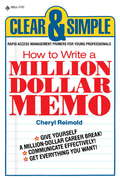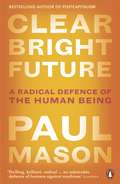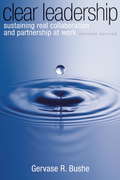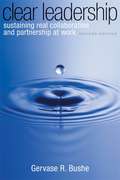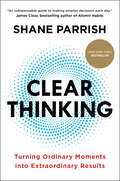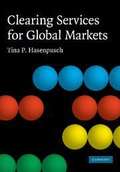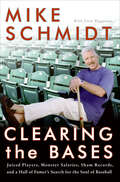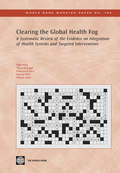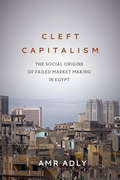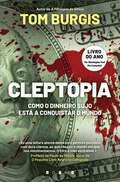- Table View
- List View
Cleaning and Corporate Management: The Historical and Theoretical Relationship Between Japanese Companies and Their Cleaning Activities
by Shin OhmoriThis book provides a new way of understanding Japanese management by focusing on the relationship between Japanese companies and their social practices. Whereas previous studies have often concentrated on the uniqueness of Japanese companies' systems (e.g., lifetime employment, the seniority system, company-specific unions) or methods (e.g., bottom-up management, Toyota production methods), this book explains the uniqueness of Japanese companies’ activities and practices. It especially highlights the day-to-day cleaning activities that many companies have practiced for numbers of years, regardless of their size or industry. Activities that continue beyond a certain period of time are called social practices, and the book clarifies how this particular social practice has historically been formed in Japanese companies and then shows what it means to keep cherishing those cleaning practices. This study consists of two parts: historical research and theoretical research. The historical research sheds light on the relationship between Japanese companies and cleaning activities from a historical point of view. On the basis of old literature and in-house documents, the reader can understand how Japanese companies have positioned cleaning practices in the process of increasing their growth potential and competitiveness and in maintaining their businesses. The second part explains theoretically the relationship between cleaning and management with quantitative and qualitative data from Japanese companies today. Using survey results from Japanese companies, the book shows what kinds of organizations will be formed and human resources will be developed if companies have been focusing for many years on 5S activities—Sort, Set in Order, Shine, Standardize, and Sustain— that include cleaning. This part of the book presents the distinctive problem-solving and strategy-creation processes of Japanese companies in contrast to the activities of European and American companies.
Cleansed
by Marcel LejeuneThose caught in the grip of porn may withdraw in shame and despair, thinking there is no hope. Author Marcel LeJeune shows readers that the road to freedom from pornography cannot and should not be traveled alone. LeJeune offers scientific evidence of the addictive and destructive power of pornography, and provides resources and suggestions for keeping your home and family safe.
Clear & Simple: How to Write a Million Dollar Memo
by Cheryl ReimoldHow to Write a Million Dollar Memo is a guide to writing clear and simple business communications.
Clear Bright Future: A Radical Defence of the Human Being
by Paul MasonA passionate defence of humanity and a work of radical optimism from the international bestselling author of PostcapitalismHow do we preserve what makes us human in an age of uncertainty? Are we now just consumers shaped by market forces? A sequence of DNA? A collection of base instincts? Or will we soon be supplanted by algorithms and A.I. anyway?In Clear Bright Future, Paul Mason calls for a radical, impassioned defence of the human being, our universal rights and freedoms and our power to change the world around us. Ranging from economics to Big Data, from neuroscience to the culture wars, he draws from his on-the-ground reporting from mass protests in Istanbul to riots in Washington, as well as his own childhood in an English mining community, to show how the notion of humanity has become eroded as never before.In this book Paul Mason argues that we are still capable - through language, innovation and co-operation - of shaping our future. He offers a vision of humans as more than puppets, customers or cogs in a machine. This work of radical optimism asks: Do you want to be controlled? Or do you want something better?
Clear Channel Communications, Inc.
by Felix Oberholzer-Gee Carole A. WinklerDiscusses the rise of Clear Channel Communications, Inc. (CC) as the most important radio broadcasting company in the United States. While CC can look back on a glorious past, it faces a multitude of business issues: radio listenership is in decline, media deregulation has come to a halt, and the company's public image is less than favorable.
Clear Leadership: Sustaining Real Collaboration and Partnership at Work
by Gervase BusheGervase R. Bushe one of HR Magazine's Most Influential Thinkers 2016What happened to that win-win partnership with your boss, colleage, or direct report that suddenly dissolved into mistrust and suspicion? Despite your best intentions, how did hidden agendas, unresolved conflicts, and miscommunication get in the way? With new research, fresh insight, and up-to-date examples of what it takes to collaborativelyy organize and sustain healthy relationships at work, this newly revised edition of Clear Leadership tackles these issues head-on. Building on the powerful concepts that made the first edition such a success, Gervase Bushe explains why even the most promising partnerships get derailed and what you can do about it.
Clear Leadership: Sustaining Real Collaboration and Partnership at Work
by Gervase R. BusheWith new research, fresh insight, and up-to-date examples of what it takes to organize and sustain healthy relationships at work, Clear Leadership tackles the big issues head on. Building on the powerful concepts that made the first edition such a success, Gervase Bushe explains why even the most promising partnerships get derailed and what you can do about it.
Clear Link Technologies, LLC: Driving Sales with Peer Effects
by Olivia Hull Christopher Stanton Richard SaoumaThe importance of a good peer or coworker is widely discussed, but understanding the glue that makes coworkers valuable is less understood. This case sheds light on the importance of peers and the practices and environments that make a group greater than the sum of its parts. Facing threats to its growth, digital marketing and sales company Clear Link Technologies, LLC (Clearlink) decided to run an experiment to test strategies for improving sales productivity. The experiment compares the efficacy of two interventions: group incentives and management-directed peer learning. The case surfaces some of the mechanisms driving peer effects in the workplace and the managerial levers to tap into peer effects for improving operations. The case also provides an introduction to experiments in organizations and how these experiments may differ from traditional randomized controlled trials in marketing or pharmaceutical development.
Clear Link Technologies, LLC: Driving Sales with Peer Learning (A)
by Olivia Hull Christopher Stanton Richard SaoumaCase
Clear Thinking: Turning Ordinary Moments into Extraordinary Results
by Shane ParrishFew things will change your trajectory in life or business as much as learning to think clearly. Yet few of us recognize opportunities to think in the first place.You might believe you&’re thinking clearly in the moments that matter most. But in all likelihood, when the pressure is on, you won&’t be thinking at all. And your subsequent actions will inevitably move you further from the results you ultimately seek—love, belonging, success, wealth, victory. According to Farnam Street founder Shane Parrish, we must get better at recognizing these opportunities for what they are, and deploying our cognitive ability in order to achieve the life we want.Clear Thinking gives you the tools to recognize the moments that have the potential to transform your trajectory, and reshape how you navigate the critical space between stimulus and response. As Parrish shows, we may imagine we are the protagonists in the story of our lives. But the sad truth is, most of us run on autopilot. Our behavioral defaults, groomed by biology, evolution, and culture, are primed to run the show for us if we don&’t intervene. At our worst, we react to events without reasoning, not even realizing that we&’ve missed an opportunity to think at all. At our best, we recognize these moments for what they are, and apply the full capacity of our reasoning and rationality to them.Through stories, mental models, and more, Parrish offers the missing link between behavioral science and real-life outcomes. The result is a must-have manual for optimizing decision-making, gaining competitive advantage, and living a more intentional life.
Clear Thinking: Turning Ordinary Moments into Extraordinary Results
by Shane ParrishINSTANT NEW YORK TIMES BESTSELLER * GLOBE AND MAIL BESTSELLER * TORONTO STAR BESTSELLERFew things will change your trajectory in life or business as much as learning to think clearly. Yet few of us recognize opportunities to think in the first place.You might believe you&’re thinking clearly in the moments that matter most. But in all likelihood, when the pressure is on, you won&’t be thinking at all. And your subsequent actions will inevitably move you further from the results you ultimately seek—love, belonging, success, wealth, victory. According to Farnam Street founder Shane Parrish, we must get better at recognizing these opportunities for what they are, and deploying our cognitive ability in order to achieve the life we want.Clear Thinking gives you the tools to recognize the moments that have the potential to transform your trajectory, and reshape how you navigate the critical space between stimulus and response. As Parrish shows, we may imagine we are the protagonists in the story of our lives. But the sad truth is, most of us run on autopilot. Our behavioral defaults, groomed by biology, evolution, and culture, are primed to run the show for us if we don&’t intervene. At our worst, we react to events without reasoning, not even realizing that we&’ve missed an opportunity to think at all. At our best, we recognize these moments for what they are, and apply the full capacity of our reasoning and rationality to them.Through stories, mental models, and more, Parrish offers the missing link between behavioral science and real-life outcomes. The result is a must-have manual for optimizing decision-making, gaining competitive advantage, and living a more intentional life.
Clear Writing Means Clear Thinking Means . . .
by Marvin H. SwiftThe general manager of a corporation circulates a memo advising his employees on company policy about copier use. He carefully revises his original memo and in the process crystallizes his own thinking on the issue. Writing well and thinking well are interrelated. Because rewriting demands objectivity, an ability to separate essential from nonessential ideas, and a willingness to locate and correct contradictions, it provides the key to improved thinking.
ClearChoice Dental Implant Centers
by Robert S. Kaplan Ashiana Jivraj Jane BarrowThe case illustrates the application of value-based health care to dental medicine. ClearChoice Dental Implant Centers was a rapidly-growing network of dentist-owned independent implant clinics. The targeted market included 23 million people, 15% of the US adult population aged 65 or older, who were completely edentulous (toothless), and the 12 million more who were edentulous in either their upper or lower jaw. Relative to dentures, dental implants enabled stronger biting forces and greater chewing capacity, leading to healthier diets and a higher quality of life. Each ClearChoice clinic was staffed with a multidisciplinary care team to provide one-site, full-mouth dental implant restorations during a single surgical day. ClearChoice Management Services provided management and administrative support to all the clinics in the ClearChoice network, including a proprietary electronic dental records system to capture patient information, patient reported outcomes (PROs), site costing, and process times. CEO Kevin Mosher wanted to double the company's size within three years, and faced the challenge of sustaining its highly-rated patient experiences and excellent patient outcomes during the next period of rapid growth.
ClearEyes Cataracts Clinic
by Roy D. Shapiro Paul E. MorrisonDr. Julia Connors has a busy, successful cataract clinic and wants to expand to meet demand. She is considering two alternatives: keeping her physical facility as it is and extending office hours, or renting additional space within her current building. The first appears to be less disruptive to operations but risks alienating her workforce. The second is more disruptive to current operations during construction and will require more capital investment. This case is designed to be taught in a single class session with students who have practiced process analysis.
ClearScore, 2018
by John R. Wells Benjamin WeinstockIn October 2017, Experian, one of the "Big Three" consumer credit reporting agencies in the United Kingdom made an offer to acquire ClearScore for a total consideration of 293 million. Founded by Justin Basini, Dan Cobley, and Nigel Morris in 2014, ClearScore was the UK's first company to offer consumers full credit reports and scores for free. ClearScore had accumulated over 5 million customers since its launch on July 15, 2015, and was growing rapidly. In the final quarter of 2017, it was set to reach break-even and deliver 27 million in revenues for the year. Was this the time to sell?
Clearing Services for Global Markets: A Framework for the Future Development of the Clearing Industry
by Tina P. HasenpuschClearing forms the core part of a smooth and efficiently functioning financial market infrastructure. Traditionally, it has been provided by clearing houses, most of which today act as a 'central counterparty' (CCP) between the two sides of a trade. The rapid growth of cross-border trading has sparked discussion on the most efficient industry structure - particularly in Europe and the US. At the heart of this discussion lies the question of whether the implementation of a single clearing house creates greater benefits than a more competitive but interlinked market structure. This is the starting point for this book, which analyses the efficiency of clearing and clearing industry structure. Along with clear-cut definitions and a concise characterisation and descriptive analysis of the clearing industry, the book determines the efficiency impact of various cross-border integration and harmonisation initiatives between CCPs. This serves to identify the most preferable future structure for the clearing industry.
Clearing the Bases: Juiced Players, Monster Salaries, Sham Records, and a Hall of Famer's Search for the Soul of Baseball
by Glen Waggoner Mike SchmidtClearing the Bases is a much-needed call to arms by one of baseball's most respected players. Drawing on his experiences as a third baseman, a manager, and, most recently, a fan, Mike Schmidt takes on everything from skyrocketing payrolls, callous owners, and unapproachable players to inflated statistics, and, of course, ersatz home run kings. But Schmidt's book goes beyond the Balco investigation and never-ending free-agent bonanzas that dominate the back pages. It also examines all that's right with our national pastime, including interleague play, expansion, and, most surprisingly, better all-around hitters. Riveting, wise, and illuminating, Clearing the Bases is a hall of famer's look at how Major League Baseball has lost its way and how it can head back home.
Clearing the Global Health Fog
by Olusoji Adeyi Thyra De Jongh Kelechi Ohiri Federica V. Secca Rifat AtunA longstanding debate on health system organization relates to the benefits of integrating programs that emphasize specific interventions into mainstream health systems to increase access and improve health outcomes. This debate has long been characterized by polarization of views and ideologies, with protagonists for and against integration arguing relative merits of each approach. Recently, the debate has been rekindled due to substantial rises in externally-funded programs for priority health, nutrition, and population (HNP) interventions and an increase in international efforts aimed at health system strengthening. However, all too frequently these arguments have not been based on hard evidence. In this book we present findings of a systematic review that explores a broad range of evidence on: (i) the extent and nature of integration of targeted health programs that emphasize specific interventions into critical health systems functions; (ii) how the integration or non-integration of health programs into critical health systems functions in different contexts have influenced program success; and (iii) how contextual factors have affected the extent to which these programs were integrated into critical health systems functions. The findings provide a new synthesis of evidence to inform the debate on health systems and targeted interventions. In practice a rich mix of solutions exists. While the discussion on the relative merits of integrating health interventions will no doubt continue, discussions should move away from the highly-reductionist approach that has polarized this debate.
Clearwater Seafoods
by Forest ReinhardtClearwater sought to market value-added shellfish products in a traditionally commodities based industry, while facing supply uncertainties and regulatory, environmental, and foreign exchange challenges. Clearwater harvested lobsters, clams, scallops, shrimp, and other marine creatures from the Canadian Atlantic, and sold the seafood all over the world. Although seafood buyers traditionally bought on price, Clearwater's innovations and technology investments enabled it to produce higher quality products; still, it faced the challenge of convincing buyers to pay a premium price. The firm's managers also prided themselves on their sustainable fishing practices, which were not the historical norm for the industry; here, again, translating these practices into increased willingness to pay was a challenge. As background, the case also discusses the challenges of fishery management at the national and international levels, using the collapse of the cod fishing industry as an example, and discussing the economics and politics of the fishery in classical terms of externalities and public goods.
Clef Company: Turnover
by Frank V. CespedesThe Clef case focuses on the issue of turnover in a firm's sales force. Students must analyze the factors contributing to turnover as well as the role of the field sales force in Clef's profitable business strategy. Among other things, the Clef case illustrates that managing field marketing requirements entails managing individual people but also a certain aggregate call capacity and a set of sales tasks determined by business strategy. In turn, that analysis of strategy-sales linkages often changes students' minds about what to do about turnover in Clef's sales force.
Cleft Capitalism: The Social Origins of Failed Market Making in Egypt (Stanford Studies in Middle Eastern and Islamic Societies and Cultures)
by Amr AdlyEgypt has undergone significant economic liberalization under the auspices of the International Monetary Fund, the World Bank, USAID, and the European Commission. Yet after more than four decades of economic reform, the Egyptian economy still fails to meet popular expectations for inclusive growth, better standards of living, and high-quality employment. While many analysts point to cronyism and corruption, Amr Adly finds the root causes of this stagnation in the underlying social and political conditions of economic development. Cleft Capitalism offers a new explanation for why market-based development can fail to meet expectations: small businesses in Egypt are not growing into medium and larger businesses. The practical outcome of this missing middle syndrome is the continuous erosion of the economic and social privileges once enjoyed by the middle classes and unionized labor, without creating enough winners from market making. This in turn set the stage for alienation, discontent, and, finally, revolt. With this book, Adly uncovers both an institutional explanation for Egypt's failed market making, and sheds light on the key factors of arrested economic development across the Global South.
Cleptopia: Como o Dinheiro Sujo Está a Conquistar o Mundo
by Tom BurgisO PREMIADO JORNALISTA DE INVESTIGAÇÃO TOM BURGIS EXPÕE UMA TERRÍVEL REDE GLOBAL DE CORRUPÇÃO FINANCEIRA Cleptopia segue o dinheiro sujo que está a inundar a economia global, a encorajar ditadores e a envenenar as democracias. Do Kremlin a Pequim, do Médio Oriente à Casa Branca, Tom Burgis mostra como os corruptos se estão a unir — e o terrível custo que tem essa união. Vislumbres desse mundo sombrio têm surgido nos últimos anos: um corpo é encontrado num Audi carbonizado; trabalhadores são crivados de balas no deserto do Cazaquistão; uma eleição fraudulenta tem lugar no Zimbabwe; um banqueiro britânico é silenciado e humilhado por tentar expor a verdade sobre a City de Londres — o cofre do mundo para o dinheiro sujo. Neste thriller da vida real, repleto de revelações perturbadoras, entrelaçam-se várias histórias que revelam uma assustadora teia global de corrupção, proporcionando uma visão chocante de um mundo de evasão fiscal, espionagem e, acima de tudo, desejo de poder. «Só uma leitura atenta deste livro permite perceber, com dura clareza, ao que chegou o mundo em que nos movimentamos. O livro é imprescindível.» Prefácio de Paulo de Morais, autor de O Pequeno Livro Negro da Corrupção «Um relato magistral do dinheiro e da violência por trás das ditaduras mais poderosas do mundo.» The Washington Post «Uma história sinistra, mas muito importante.» The Guardian «Uma peça de investigação jornalística meticulosamente pesquisada, escrita como se fosse um thriller de cortar a respiração. Cleptopia não é um país distantena Ásia Central; está do outro lado da fronteira.» The Times «Leia Cleptopia já. Não há tempo a perder. Tom Burgis demonstra que o dinheiro realmente fede — e mostra como seguir o seu cheiro.» Roberto Saviano, autor de Gomorra «Quando começar a ler não conseguirá parar até chegar ao fim.» Misha Glenny, autor de Némesis — A Caça ao Criminoso Mais Procurado do Brasil «Tom Burgis combina jornalismo de investigaçãoforense e narrativa com o ritmo de um thriller. O resultado é uma leitura compulsiva que se revela mais chocante por ser a realidade.» Nathan Filer, autor de O Choque da Queda
Cleveland Beer: History & Revival in the Rust Belt
by Peter Chakerian Leslie BasallaCleveland loves its craft beer. The city's breweries are flourishing under a period of brewing renewal and an insatiable taste for quality local craftsmanship. But Cleveland's brewing industry hasn't always enjoyed such prosperous times. The industry boomed during the 1800s only to see Prohibition, dwindling demand and increased competition stifle production. Each brewery, one by one, closed its doors until none remained. In 1988, Patrick and Daniel Conway opened the fledgling Great Lakes Brewing Company, and the industry was born anew. Today, local visionaries are engineering the comeback and bringing national attention to Cleveland's award-winning craft brews. Authors Leslie Basalla and Peter Chakerian chart the remarkable history of the ups and downs of Cleveland beer.
Cleveland Clinic
by Amy C. Edmondson Eliot Sherman Frances X. Frei Christine Harris-Van KeurenCleveland Clinic is consistently ranked among the nation's most eminent hospitals, and for decades has been a leader in pioneering cardiac care. Explores the methods, processes, and personnel that the hospital has cultivated over the years in order to develop its track record of excellence. In light of this, three expansion opportunities are explored and the operational fit of each is investigated.
Cleveland Clinic Abu Dhabi
by Linda A. Hill Emily TedardsIn 2006, the Cleveland Clinic and Mubadala Investment Company partnered with a bold ambition to deliver world class healthcare in the United Arab Emirates. In 2015, after nearly a decade of planning and construction, Cleveland Clinic Abu Dhabi opened its doors. By 2017, the hospital had proven it could deliver Cleveland Clinic-quality care 7,000 miles away from its main campus. Dr. Rakesh Suri, Chief of Staff at the time, became Cleveland Clinic Abu Dhabi's Chief Executive Officer; his mandate was to grow the hospital into one of the most innovative academic medical centers in the world, while marching toward financial sustainability. As a newer hospital, Cleveland Clinic Abu Dhabi endured its share of growing pains as it worked to cultivate a culture of innovation and take full advantage of its information technology and business intelligence capabilities. By 2019, there were so many innovation initiatives underway that the executive team was considering whether to implement a Priority Index to foster a more coordinated approach to innovation.


